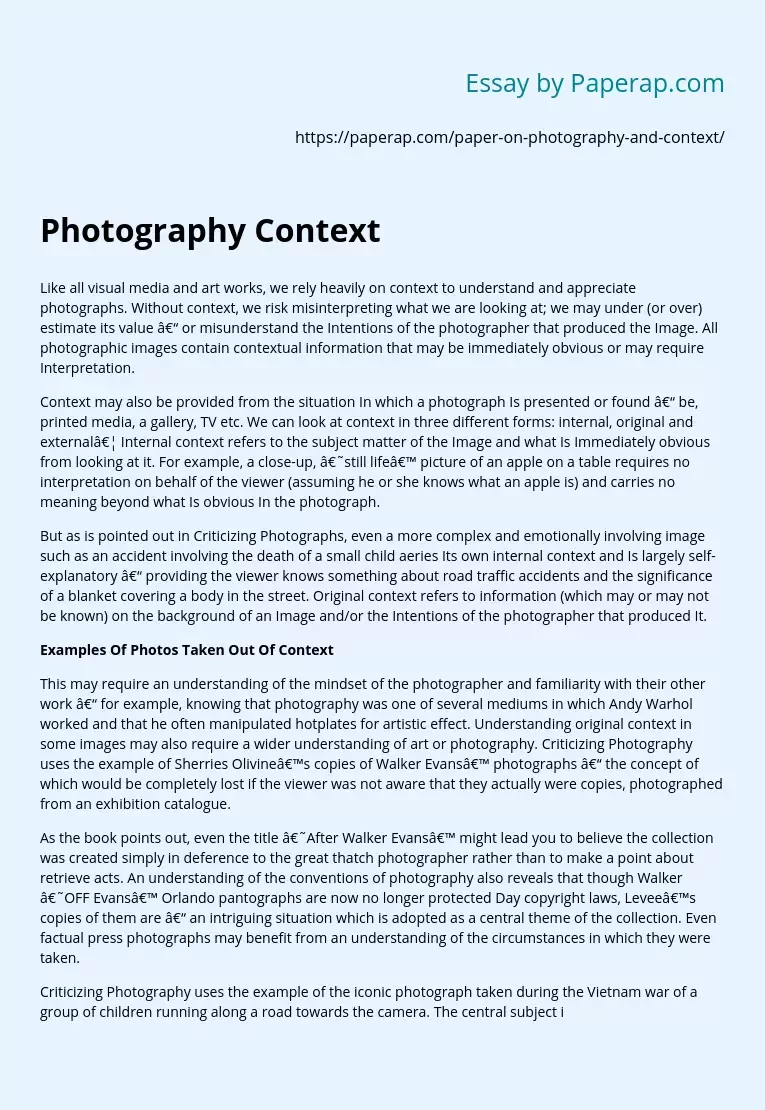Photography Context
Like all visual media and art works, we rely heavily on context to understand and appreciate photographs. Without context, we risk misinterpreting what we are looking at; we may under (or over) estimate its value – or misunderstand the Intentions of the photographer that produced the Image. All photographic images contain contextual information that may be immediately obvious or may require Interpretation.
Context may also be provided from the situation In which a photograph Is presented or found – be, printed media, a gallery, TV etc.
We can look at context in three different forms: internal, original and external… Internal context refers to the subject matter of the Image and what Is Immediately obvious from looking at it. For example, a close-up, ‘still life’ picture of an apple on a table requires no interpretation on behalf of the viewer (assuming he or she knows what an apple is) and carries no meaning beyond what Is obvious In the photograph.
But as is pointed out in Criticizing Photographs, even a more complex and emotionally involving image such as an accident involving the death of a small child aeries Its own internal context and Is largely self-explanatory – providing the viewer knows something about road traffic accidents and the significance of a blanket covering a body in the street.
Original context refers to information (which may or may not be known) on the background of an Image and/or the Intentions of the photographer that produced It.
Examples Of Photos Taken Out Of Context
This may require an understanding of the mindset of the photographer and familiarity with their other work – for example, knowing that photography was one of several mediums in which Andy Warhol worked and that he often manipulated hotplates for artistic effect.
Understanding original context in some images may also require a wider understanding of art or photography. Criticizing Photography uses the example of Sherries Olivine’s copies of Walker Evans’ photographs – the concept of which would be completely lost if the viewer was not aware that they actually were copies, photographed from an exhibition catalogue.
As the book points out, even the title ‘After Walker Evans’ might lead you to believe the collection was created simply in deference to the great thatch photographer rather than to make a point about retrieve acts. An understanding of the conventions of photography also reveals that though Walker ‘OFF Evans’ Orlando pantographs are now no longer protected Day copyright laws, Levee’s copies of them are – an intriguing situation which is adopted as a central theme of the collection. Even factual press photographs may benefit from an understanding of the circumstances in which they were taken.
Criticizing Photography uses the example of the iconic photograph taken during the Vietnam war of a group of children running along a road towards the camera. The central subject is young girl, naked and crying with her arms outstretched. Such a traumatic image could have emerged from virtually any war in the thatch. However, with the benefit of background information – ‘e, original context – we learn that the children have been attacked by mistake by an American plane and that the girl has torn her own clothes off to prevent napalm burning her skin.
Though such information isn’t required for us to understand the horror of what is shown in the photograph, it does provide us with context which affects our interpretation of what we are seeing. External context can be derived from the situation in which photographs are viewed. An obvious example of this would be an image hung in an art gallery which we would probably be more ready to identify as ‘art’ than a picture in a newspaper which we would see as factual.
As Criticizing Photography points out: every photograph has an external context – whether this happens intentionally or accidentally – and that our appreciation of an image is colored by the situation in which we view it. This is even true of photographs appearing in similar but different media. For example, we are more likely to accept the truthfulness of an image that appears on the front page of The Times than we are on The Daily Star. Similarly.
We are also more likely to accept a photograph as a genuine work of art if it is found hanging in major international gallery than we would if it was entered at a local photographic competition. Criticizing Photography uses the example of a photograph taken by Robert Doziness in a French cafe© in 1953. Because it was sold by his agent to several different organizations, this same image was used to illustrate French cafe© life, to warn against he evils of alcohol and to accompany an article on the problem of prostitution in Paris.
This provides us with a graphic illustration of how external context affects how we interpret images. Conclusion What arises from this discussion is the camera’s ability to take virtually any image out of its original context and create a new context for it. The simple act of deciding what to Include In ten Trade Ana want to leave out – Ana when to clock ten saunter – effectively removes an image from its original position in space and time and places it in a new context that we, as viewers, are left to interpret.
Photography Context. (2019, Dec 05). Retrieved from https://paperap.com/paper-on-photography-and-context/

